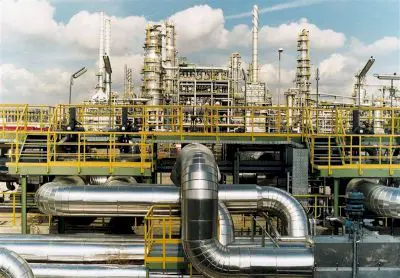Ethane: LNG, ethane dichloride, ethane trichloride Kerosene: lubricating oils, white oil, normal olefin, paraffin, alkane sulfonate, sulfur Propane: Liquefied petroleum gas, propylene, dichloropropane Butane: Butylene, isobutene From these six categories, many outputs are generated leading to the production cycle, some of which we mention in this section: "Chemical fertilizers, urea, diammonium phosphate, ammonium nitrate mixture fertilizers, plastic raw materials, PVC and DOP, chemicals such as sulfuric acid, hydrochloric acid, ammonia, sulfur, soot, etc

West Asia has abundant reserves of crude oil, and countries like Saudi Arabia, Iraq, Iran, Kuwait, and the United arab emirates are among the largest producers in the world. These countries extract Crude oil from onshore and offshore fields, which serves as the primary feedstock for their refining operations. West asia is home to several large and technologically advanced refineries. Countries like Saudi Arabia, Iran, and the United Arab Emirates have invested heavily in developing refineries with high processing capacities. These refineries often incorporate advanced technologies to maximize efficiency and product yields.
The first step in crude oil refining is distillation. Crude oil is heated in a distillation tower, and its various components are separated based on their boiling points. The lighter fractions, such as gasoline and liquefied Petroleum gas (LPG), vaporize and rise to the top of the tower, while heavier fractions, including diesel, kerosene, and fuel oil, are collected at different levels. After distillation, further processing is carried out to convert the heavier fractions into more valuable products. Conversion processes, such as catalytic cracking and hydrocracking, break down large hydrocarbon molecules into smaller ones, producing additional gasoline, diesel, and jet fuel.
The processing of oil yields various outputs, which can be categorized into six main groups. The first group is naphtha, which produces a range of products including ethylcellulose, acetic acid, methane, synthetic gas, acetaldehyde, ethylbenzene, ethyl bromide, alpha-olefin, Ethylene oxide, ethylene dichloride, butene, ethanol, ethylene rubber, and propionic acid. The second group is ethane, which results in products such as liquefied natural gas (LNG), ethane dichloride, and ethane trichloride. Kerosene, the third group, is used to produce lubricating oils, white oil, normal olefin, paraffin, and alkane sulfonate. The fourth group is propane, which is converted into liquefied petroleum gas (LPG) and propylene. The fifth group, butane, yields products like butylene and isobutene. These six groups generate a wide range of outputs that contribute to the production cycle.
Within this production cycle, several notable outputs are obtained. One significant output is Chemical fertilizers, including urea, diammonium phosphate, and ammonium nitrate mixture fertilizers. These fertilizers play a crucial role in agriculture and contribute to increased crop yields. Another important output is plastic raw materials, which are used in the production of various plastic products. Polyvinyl chloride (PVC) and dioctyl phthalate (DOP) are specific types of plastic raw materials derived from the oil refining process.
Additionally, the production cycle generates various Chemicals such as sulfuric acid, hydrochloric acid, ammonia, sulfur, and soot. These chemicals have numerous industrial applications, including use in manufacturing processes, water treatment, and the production of various consumer goods. Overall, the refining of oil leads to a diverse range of outputs that contribute to multiple industries, including agriculture, plastics, and chemical manufacturing. The utilization of these outputs in the production cycle drives economic development and supports various sectors in meeting their energy and material needs.
Many refineries in West Asia are integrated with Petrochemical complexes, allowing for the production of Petrochemicals alongside refined products. This integration maximizes the value derived from crude oil by producing chemicals such as ethylene, propylene, and aromatics, which serve as feedstocks for the petrochemical industry. Crude oil energy is divided into three general categories and products: "fuel, energy, and fibers". These three items have been one of the most basic needs of early man and modern man. Therefore, petrochemicals products will be classified based on these needs.





